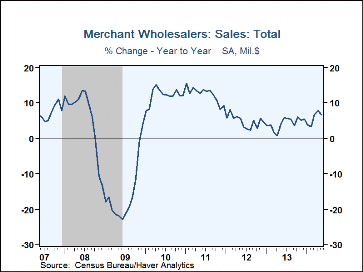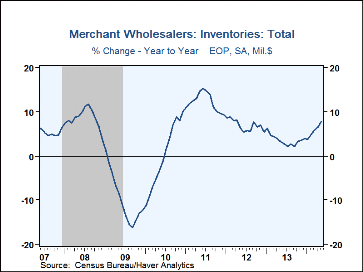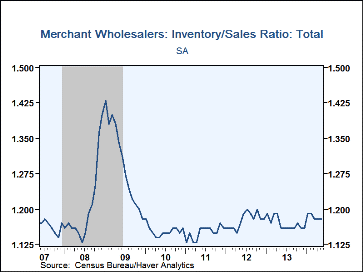 Global| Jul 10 2014
Global| Jul 10 2014U.S. Wholesale Inventories and Sales Moderate M/M
by:Tom Moeller
|in:Economy in Brief
Summary
Wholesale sales increased 0.7% (6.6% y/y) during May following an unrevised 1.3% gain in April. In the durable goods sector, sales inched 0.2% higher (5.9% y/y) after 1.6% increases in the prior two months. The latest rise was held [...]
 Wholesale sales increased 0.7% (6.6% y/y) during May following an
unrevised 1.3% gain in April. In the durable goods sector, sales inched
0.2% higher (5.9% y/y) after 1.6% increases in the prior two months. The
latest rise was held back by a 1.6% decline (+5.5% y/y) in sales of
computer equipment. Furniture sales also were off 1.1% (+3.2% y/y) and
electrical and electronic goods sales fell 1.1% (+5.7% y/y). Offsetting
these declines were a 3.2% increase (11.3% y/y) in metals, a 1.1% gain in
automotive (4.0% y/y) and a 1.0% rise (12.0% y/y) in machinery sales.
Nondurable goods sales improved 1.1% (7.2% y/y) and repeated the April
gain. Farm products led the increase with a 6.6% rise (6.7% y/y) while
apparel sales rose 2.0% (10.7% y/y). Chemical sales increased 1.4% (9.8%
y/y) but paper products sales fell 1.0% (+4.2% y/y). Grocery product sales
slipped 0.3% (+4.8% y/y) and petroleum & product sales were unchanged
(+12.3% y/y).
Wholesale sales increased 0.7% (6.6% y/y) during May following an
unrevised 1.3% gain in April. In the durable goods sector, sales inched
0.2% higher (5.9% y/y) after 1.6% increases in the prior two months. The
latest rise was held back by a 1.6% decline (+5.5% y/y) in sales of
computer equipment. Furniture sales also were off 1.1% (+3.2% y/y) and
electrical and electronic goods sales fell 1.1% (+5.7% y/y). Offsetting
these declines were a 3.2% increase (11.3% y/y) in metals, a 1.1% gain in
automotive (4.0% y/y) and a 1.0% rise (12.0% y/y) in machinery sales.
Nondurable goods sales improved 1.1% (7.2% y/y) and repeated the April
gain. Farm products led the increase with a 6.6% rise (6.7% y/y) while
apparel sales rose 2.0% (10.7% y/y). Chemical sales increased 1.4% (9.8%
y/y) but paper products sales fell 1.0% (+4.2% y/y). Grocery product sales
slipped 0.3% (+4.8% y/y) and petroleum & product sales were unchanged
(+12.3% y/y).
Inventories at the wholesale level gained 0.5% (7.9% y/y) during May. That followed a 1.0% April increase, revised from 1.1%, and a 1.1% March gain. The rise owed to a 1.0% improvement (8.5% y/y) in durable goods inventories, led by a 1.9% gain (10.4% y/y) in automotive inventories. Lumber & construction materials inventories increased 1.2% (8.6% y/y) and machinery inventories rose 1.1% (13.5% y/y). To the downside, nondurable goods inventories were off 0.3% (+6.9% y/y), led lower by a 3.2% decline (+5.3% y/y) in farm products and a 1.9% drop (+2.4% y/y) in groceries. To the upside were petroleum inventories by 2.0% (-0.8% y/y) and chemicals inventories by 0.5% (5.7% y/y). Apparel inventories were roughly unchanged (6.8% y/y).
The wholesale sector's inventory-to-sales ratio held m/m at 1.18 for the third straight month. It's risen, however, from 1.16 at year-end. In the durable goods sector, the I/S ratio increased to 1.59 versus its low of 1.49 during all of 2011. In the nondurables sector, the I/S ratio of 0.83 neared the expansion low led down by a 0.32 ratio in petroleum.
The wholesale trade figures are available in Haver's USECON database.
Income Inequality and Monetary Policy: A Framework with Answers to Three Questions from the Federal Reserve Bank of St. Louis can be found here.
| Wholesale Sector - NAICS Classification (%) | May | Apr | Mar | Y/Y | 2013 | 2012 | 2011 |
|---|---|---|---|---|---|---|---|
| Inventories | 0.5 | 1.0 | 1.1 | 7.9 | 4.0 | 5.5 | 9.4 |
| Sales | 0.7 | 1.3 | 1.6 | 6.6 | 4.3 | 4.8 | 12.4 |
| I/S Ratio | 1.18 | 1.18 | 1.18 | 1.16 (May'13) | 1.17 | 1.18 | 1.15 |
Tom Moeller
AuthorMore in Author Profile »Prior to joining Haver Analytics in 2000, Mr. Moeller worked as the Economist at Chancellor Capital Management from 1985 to 1999. There, he developed comprehensive economic forecasts and interpreted economic data for equity and fixed income portfolio managers. Also at Chancellor, Mr. Moeller worked as an equity analyst and was responsible for researching and rating companies in the economically sensitive automobile and housing industries for investment in Chancellor’s equity portfolio. Prior to joining Chancellor, Mr. Moeller was an Economist at Citibank from 1979 to 1984. He also analyzed pricing behavior in the metals industry for the Council on Wage and Price Stability in Washington, D.C. In 1999, Mr. Moeller received the award for most accurate forecast from the Forecasters' Club of New York. From 1990 to 1992 he was President of the New York Association for Business Economists. Mr. Moeller earned an M.B.A. in Finance from Fordham University, where he graduated in 1987. He holds a Bachelor of Arts in Economics from George Washington University.








